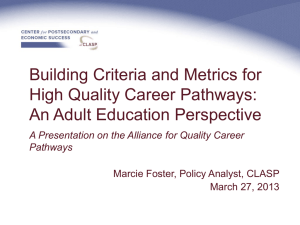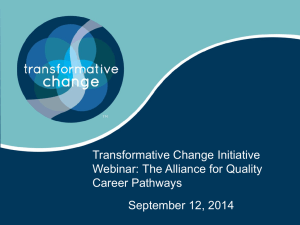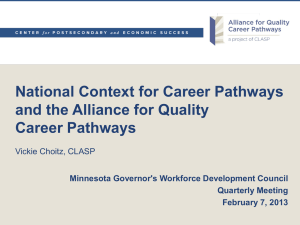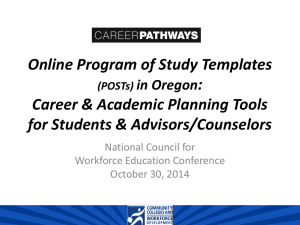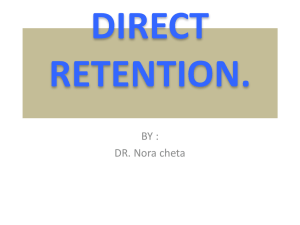Defining High-Quality Career Pathway Systems
advertisement
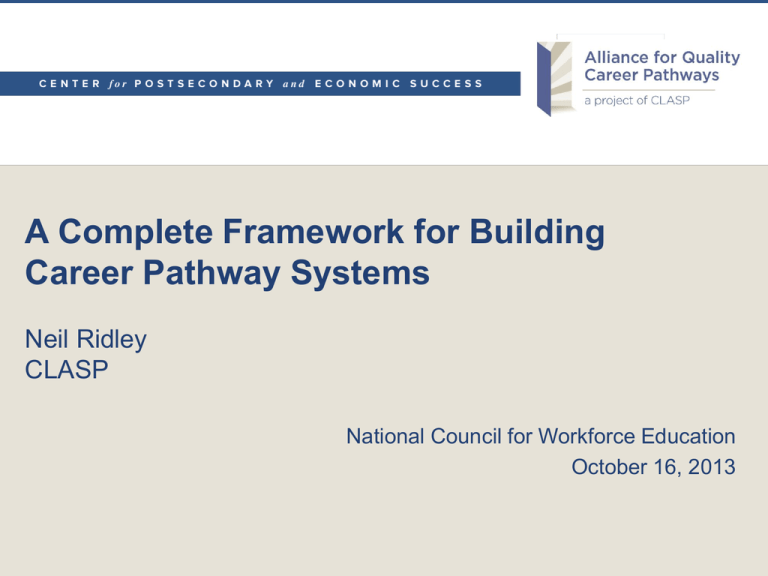
A Complete Framework for Building Career Pathway Systems Neil Ridley CLASP National Council for Workforce Education October 16, 2013 CLASP: Policy Solutions that Work for Low-Income People • CLASP develops and advocates for policies that improve the lives of low-income people. • Our Center for Postsecondary and Economic Success, launched in 2010, advocates for policies, investments, and political will that help increase the number of low-income adults and out-of-school youth who earn postsecondary credentials. • CLASP managed the Shifting Gears initiative and provided technical assistance to the six partner states. Shifting Gears supported state-level inter-agency teams to build pathways to postsecondary credentials for low-skilled adults in the Midwest. • CLASP facilitates the Alliance for Quality Career Pathways 2 Recent Federal Support for [Adult] Career Pathways • Grants o Health Profession Opportunity Grants (HHS, 2010) o Workforce Innovation Fund and TAACCCT (rounds I-III) grants (DOL, 2012-2013) o Advancing Career and Technical Education in State and Local Career Pathway Systems (OVAE, 2012) o Technical Assistance to Build State Career Pathway Systems (OVAE, 2013) • Guidance and TA o Federal Career Pathways Institute (DOL and ED, 2010-2011) o Joint letter of commitment to promote use of career pathways (DOL, ED, and HHS, April 2012) • Evaluation o ISIS evaluation of career pathway programs (HHS, launched in late 2007; 10 year initiative) • Looking forward o o o o Round IV of TAACCCT $8b Community College to Career Fund in the President’s FY14 budget $12.5b Pathways Back to Work in the President’s FY14 budget All indications are that the federal government will continue to support and promote career pathways State and Foundation Support for Career Pathways • ~11 have explored or adopted career pathways for educationally underprepared adults and youth: AR, CA, KY, IL, MA, OH, OR, PA, VA, WA and WI • ~13 have explored or adopted career pathway bridges: IL, IN, KY, KS, LA, MD, MN, NC, OH, OR, VA, WA, and WI • Several states have explored or adopted career pathways for high school-to-college • Major national initiatives including: o Ford Bridges to Opportunity o NGA Pathways to Advancement o Breaking Through o Shifting Gears o Accelerating Opportunity The Alliance for Quality Career Pathways • 10 state alliance: Arkansas, California, Illinois, Kentucky, Massachusetts, Minnesota, Oregon, Virginia, Washington, and Wisconsin • The goal of AQCP is to identify a framework that defines highquality career pathway systems including: System criteria and quality indicators Shared set of performance metrics for measuring and managing their success • CLASP is the lead and facilitator • Funded by the Joyce Foundation and the James Irvine Foundation 5 The Alliance for Quality Career Pathways (cont.) • The final products of AQCP will be a customizable framework of criteria, indicators, and metrics and a selfassessment tool that can be used to: Enhance quality of existing career pathway systems; Build new career pathway systems more efficiently and effectively; and Inform evaluation(s) of career pathway systems. 6 Career Pathways Approach (working definition) • An approach to connecting progressive levels of basic skills and postsecondary education, training, and supportive services… --in specific sectors or cross-sector occupations --in a way that optimizes the progress and success of individuals – including those with limited education, English, skills, and/or work experience --in helping individual secure marketable credentials, familysupporting employment, and further education and employment opportunities • Career pathways help employers meet their workforce needs and help states and communities strengthen their workforces and economies. 7 Local/regional career pathways and programs: key elements 8 Career Pathway Systems “Beta” Criteria for High-Quality CP Systems • STATE 1. 2. 3. 4. Commit to a shared vision and strategy Provide resources Implement supportive state policies Use data and shared measures • LOCAL/REGIONAL 1. 2. 3. 4. 5. 6. Commit to a shared vision and strategy Engage employers Provide resources Implement supportive local/regional policies Adopt evidenced-based practices Use data and shared measures 13 AQCP career pathway metrics • A comprehensive set of career pathway metrics will support: Performance measurement of pathway programs and systems; Focus on reducing disincentives to serve underprepared and lower skilled participants. Continuous improvement of pathway programs and systems; Shared performance accountability framework; Evaluation of career pathway system impacts on participants. 14 Overview of ‘beta’ career pathway metrics A. Interim Education and Training Outcomes (9) B. Pathway Education and Training Outcomes (5) C. Labor Market Outcomes (7) Note: Not all pathways will use all metrics…it depends on the pathway design. 15 AQCP Next Steps • July-December 2013: Alliance states review and field-test framework; CLASP seek feedback outside Alliance • Winter 2014: CLASP and Alliance partners incorporate feedback • Spring 2014: CLASP and Alliance partners release “Version 1.0” of framework and self-assessment tools • Future: CLASP work with any interested states to provide technical assistance to use tool to build quality career pathway systems 16 2013 Career Pathway Forum Join United Way and CLASP (Center for Law and Social Policy) for Strengthening Your Career Pathway Systems: Tools, Tips and Tactics. Career pathways are gaining momentum as a strategy to improve regional economies and individual economic mobility. At this conference we'll explore strategies for strengthening, scaling and sustaining current career pathway innovations. DATE: Thursday, November 7 TIME: 9 a.m.– 3:30 p.m. (light breakfast at 8:30 a.m.) LOCATION: Crowne Plaza, St. Paul COST: $35 (early-bird rate); $50 (after October 17) • • • • • • • Johan Uvin, Deputy Assistant Secretary, Office of Vocational and Adult Education, U.S. Department of Education Cynthia Bauerly, Deputy Commissioner of Workforce Development, MN DEED Garret Groves, Senior Policy Analyst, National Governors Association Vickie Choitz, Senior Policy Analyst, Workforce Development, CLASP Jaclyn P. Dowd, Special Assistant for Workforce Innovation and Reform, Office of the Governor Scott Sheely, Executive Director, Lancaster County Workforce Investment Board Jennifer Foster, Associate Vice President, Illinois Adult Basic Education and Workforce Development, ICCB Thank you! Vickie Choitz Senior Policy Analyst and Director of the Alliance for Quality Career Pathways CLASP vchoitz@clasp.org 202-906-8048 Neil Ridley Senior Policy Analyst CLASP nridley@clasp.org 18


